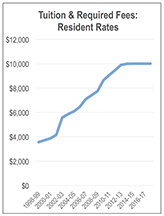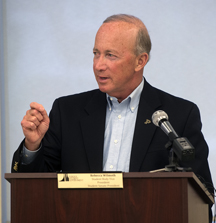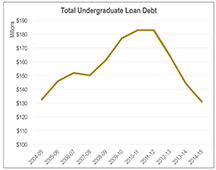April 20, 2016
Purdue plans fifth straight year without tuition increase
WEST LAFAYETTE, Ind. — Purdue University President Mitch Daniels announced Wednesday (April 20) that Purdue plans to hold tuition flat on the West Lafayette campus for a fifth consecutive year, which would extend Purdue’s tuition freeze through the 2017-2018 academic year.
 |
|
Chart showing resident tuition and fees since 1998-99. |
Tuition and fees through 2017-18 at the West Lafayette campus will remain virtually the same as they were in 2012-13 with resident students paying $10,002, out-of-state students paying $28,804 and international paying $30,804. With the additional year of flat tuition, three graduating classes (2016, 2017 and 2018) will have gone through Purdue without ever experiencing a tuition increase.
In addition to tuition and fees, Purdue has continued to hold flat or lower the cost of room and board with rates lower through 2016-17 than they were in 2012-13. Combined with the potential of lower cost books due to Purdue’s contract with Amazon, students are paying less for the overall cost of college education than their predecessors did in 2012-13.
Overall, by not raising tuition by the average national rate each year, Purdue has saved students $134 million over the first three years of the freeze. By reducing room and board rates instead of raising them at the Big Ten average, Purdue students have saved an additional $26 million since 2012.
 |
|
Purdue President Mitch Daniels on Wednesday (April 20) announces during the Purdue Student Government meeting the university's plans to hold tuition flat on the West Lafayette campus for a fifth consecutive year. (Purdue University photo/Mark Simons) |
“One of our most important goals continues to be affordability,” Daniels said. “The total cost of attendance at Purdue University is going down thanks to the efforts of all members of the Purdue family — faculty, staff and alumni — who are committed to keeping a world-class education within the reach of all students. While we cannot commit to zero increases indefinitely, our policy will always be to protect students’ family budgets, continue investing in our employees and our vital mission of delivering higher education at the highest proven value.”
Daniels announced the continued freeze at a Purdue Student Government meeting in front of a group of students, those who entered in fall 2012 or later, who have never seen a tuition increase at Purdue.
Mike Young, Purdue Student Government president, said, “The tuition freeze is having a massive, positive impact on the lives of Purdue students, and we’re very grateful for the work that has gone in to extending the freeze for another year.”
Purdue will continue its investment in teaching and research excellence and in programs that enhance the academic experience, Daniels said. Through effective fundraising, increasing sponsored research support and attention to efficient operations, Purdue has hired more faculty and funded 10 strategic initiatives, including $250 million for the Pillars of Excellence in the Life Sciences. Purdue also continues to invest in transformative projects such as the Active Learning Center, where students will experience the best new classroom teaching and learning methods; and the soon-to-open Purdue Honors College and Residences, where young scholars will come together in an intellectual and residential community designed to increase student success.
In addition, in 2015 Purdue provided a 3.5 percent pool for merit pay increases for Purdue employees, among the highest percentage increase in the country for a university, and in 2016, Daniels announced that Purdue will be able to offer a merit pool of 2.5 percent for employees.
 |
|
Chart showing undergraduate student loan debt since 2004-05. |
In addition to the freeze and other cost-cutting measures, the university has worked to bolster affordability initiatives to help reduce student debt. Financial literacy efforts combined with the other savings have helped result in a $50 million reduction in student loans (2012-2015); and, for 2015 graduates, the average debt of the 48 percent of students who graduated with debt was $27,711, about 20 percent below the national average of around $35,000.
"In short, while the tuition freeze has generated a lot of attention – and rightfully so – it's only one part of the much larger picture of increasing affordability, reducing debt and being strategic about where put our resources,” Daniels said.
Source: Mitch Daniels, president@purdue.edu

